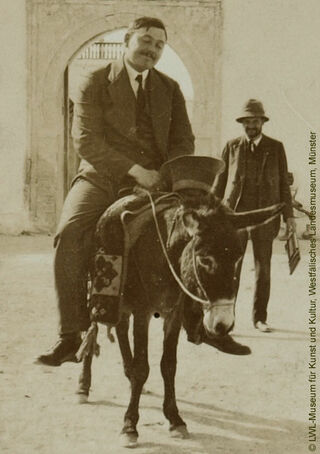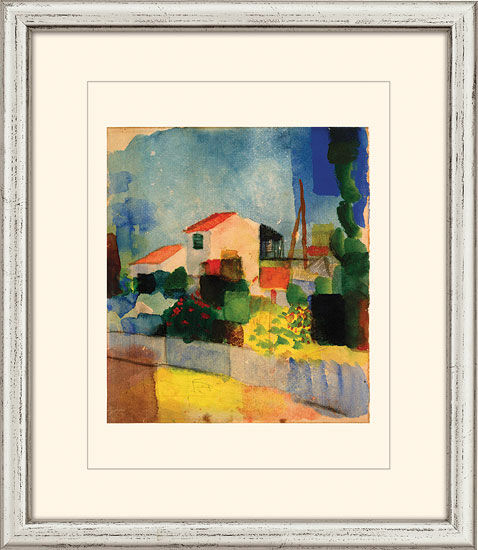Picture "The Bright House" (1914), framed


Picture "The Bright House" (1914), framed
Quick info
limited, 1,000 copies | reproduction on handmade paper | framed | size 38 x 33 cm (h/w)
Detailed description
Picture "The Bright House" (1914), framed
Paul Klee, Louis Moilliet and August Macke's trip to Tunis made art history: Under the African sun, they revolutionised their painting style one after the other, found countless motifs in the winding alleys and dealt with the themes of form and colour in a completely new way.
Their first stop was the villa district of St. Germain, today's Ez-Zahra near Tunis. Ernst Jäggi, a doctor who was a friend of Moilliet, lived here. Even to this day, his house exists. And a century after the legendary journey, Macke's Tunis paintings still bear witness to his painterly genius.
"The Bright House" (1914):
A selected work from the last and strongest period of Macke's artistic output.
1st version, Original: 1914, watercolour over pencil on handmade paper, 25.1 x 22.1 cm, Kunstmuseum, Bern.
Limited edition of 1,000 copies. The motif was lavishly reproduced on 225g embossed real handmade paper. Framed in a solid wood frame. Size 38 x 33 cm (h/w).
This object is part of the following sets
Customer reviews
Sehr guter Service!!!
Schnell und zuverlässig. So soll es sein!Danke

About August Macke
1887-1914
Radiant yellow, bright red, strong blue: the intensity and unique luminosity of the colours are typical of August Macke's work. In his paintings, Macke shows an intact world and primarily focuses on people. Probably because of the influence of his origins and the Rhenish cheerfulness, both as a person and as a painter, August Macke is considered to be one of the most famous German painters of the 20th-century.
Macke was a member of the artists' association "Blauer Reiter" and the most important representative of Rhenish Expressionism. He is considered the greatest German colour talent of his generation. But his drawings, sketches and designs also prove that he is one of the great artists of the 20th-century.
August Macke, born in Meschede on 3 January 1887, began his studies at the Kunstgewerbeschule and Kunstakademie Düsseldorf but dropped out prematurely. On journeys to France, Italy and the Netherlands he studied mainly Impressionism. With the artists of the "Blaue Reiter", whom he had known since 1911, he exhibited several times and contributed to the eponymous almanack. His financial security was assured by his sponsor Bernhard Koehler, an uncle of his wife Elisabeth.
Macke had already found his style of unmistakable independence. Inspired by Cézanne's tectonic pictorial structure and Matisse's flatness, he combined analytical Cubism with the pure colourfulness of Fauvism. The prismatic colours were the principal elements with which August Macke composed his painting. In doing so, the artist used the colours like a musician uses the tones, chords and scales of colourful forms.
As early as 1910, his friendship with Franz Marc enabled him to spend time at Lake Tegernsee. Macke's sensitivity for light effects was already evident in the paintings he created there. This is heightened in the watercolour paintings he produced on the famous trip to Tunis he made with Paul Klee and Louis Moillet in 1914. Simplification of form and the luminosity of the colours characterise this series of works.
For the first time in 1913, Macke‘s work was exhibited together with the works of the European avant-garde at the Sonderbund exhibition in Cologne, which he co-organised.
From 1913 Macke lived in Switzerland with his wife Elisabeth and his son Walter. But the family's happiness only lasted for a short time. As soon as the First Wolrd War began, August Macke was killed on the battlefield in Champagne, France, on 26 September 1914. His friend Franz Marc commented: "The greedy war is a hero's death richer, but German art poorer by one hero."
The German artists‘ association "Der Blaue Reiter" ("The Blue Rider") was founded in Munich in 1911 by Wassily Kandinsky and Franz Marc during the German Expressionist period.
The name was originally the title of the painting by Kandinsky and also the title of the almanac published by Kandinsky and Marc. Members included Paul Klee and August Macke. The group criticised the prevailing art canon as too academic and elitist and demanded more openness and diversity. The artists turned away from realism and began to paint expressively in an increasingly abstract style using strong colours.
The group disbanded at the beginning of World War I.
Artistic movement that replaced Impressionism in the early 20th century.
Expressionism is the German form of the art revolution in painting, graphic art and sculpture, which found its precursor in the works of Paul Cézanne, Vincent van Gogh and Paul Gauguin in the late 19th century. The Expressionists attempted to advance to the primal elements of painting. With vibrant, unbroken colours in large areas and with the emphasis on the line and the resulting targeted suggestive expressiveness, they fought against the artistic taste established by the bourgeoisie.
The most important representatives of Expressionism were the founders of "Die Brücke" (The Bridge): Ernst Ludwig Kirchner, Erich Heckel, Karl Schmidt-Rottluff, Max Pechstein, Otto Mueller and Franz Marc, August Macke and others.
Masters of Viennese Expressionism are Egon Schiele and Oskar Kokoschka. Among the sculptors, Ernst Barlach is the most famous.
Fauvism is the French form of Expressionism.







